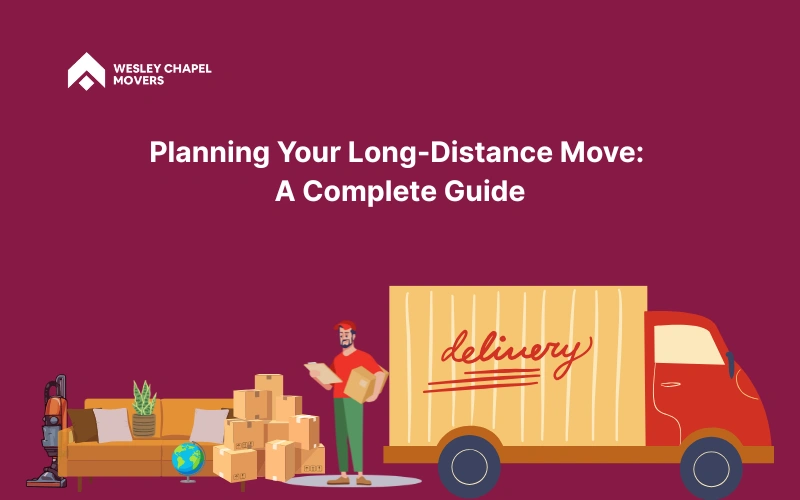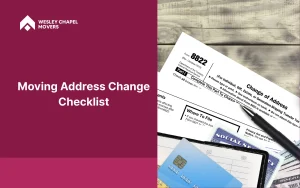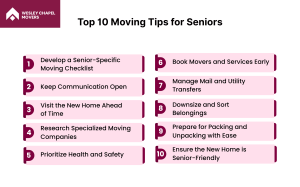Moving across state lines or even nationwide can feel like an overwhelming task, but with the right planning, your long-distance move can turn into a smooth and stress-free experience. A successful long-distance move requires careful preparation, attention to detail, and smart decision-making at every stage.
Unlike local moves, long-distance relocations come with unique challenges. Whether you are moving to a neighboring state or across the country, the complexities of logistics, cost, and time management become more complex. However, with the proper planning, you can minimize stress and ensure a smoother transition.
In this guide, we will walk you through each phase of the moving process:
- Pre-move planning: Organizing your move, creating a budget, and securing services in advance.
- Packing and logistics: Gathering packing materials, sorting items, and scheduling movers.
- Moving day: A detailed checklist to ensure nothing is overlooked.
- Post-move: Settling in, unpacking, and setting up your new home.
By breaking the process into manageable steps and preparing early, you can ensure a less stressful move. With a clear plan in place, you will confidently navigate each stage of the long-distance moving process, making your transition to a new home or office seamless.
What is Long-Distance Moving?
Long-distance moving is the process of relocating belongings over 400 miles, typically across state lines or even nationwide. Unlike local moves, which usually remain within the same city or region, long-distance relocations require more extensive planning due to the increased distance, time, and costs involved.
These moves often involve specialized services, such as larger moving trucks, additional logistics, and higher costs for both travel and time. Because of these complexities, long-distance moves are more demanding than local relocations.
There are two main types of long-distance moves:
- Residential moves: Moving personal belongings, such as furniture, household items, and personal goods, to a new home.
- Commercial moves: Relocating office furniture, equipment, and inventory for businesses to a new location.
Key factors that define a long-distance move include the distance traveled, the type of items being moved, and the level of service required. For example, moving across state lines may require permits and insurance, while moves involving large or fragile items might require special packing and handling. Identifying these factors early on helps ensure a smoother, more organized move.
Beyond packing, long-distance moving also involves careful logistics management and budgeting for extra costs. By preparing proactively, you can avoid potential challenges like weather or traffic, ensuring a seamless transition to your new home or office.
Step-by-Step Planning for Your Long-Distance Move
Planning a long-distance move requires careful organization and proactive steps to ensure everything runs smoothly. From the early stages of budgeting and booking services to the final touches of settling in at your new home, a structured approach will help you stay on track and minimize stress. Here’s a comprehensive step-by-step guide to help you navigate the moving process, with practical tips for each stage:
1-2 Months Before the Move
The first 1-2 months before your long-distance move are crucial for laying the groundwork. At this stage, focus on organizing, booking services, and reducing clutter to make the upcoming move more manageable.
- Create a Moving Timeline
- Develop a detailed moving timeline that includes key tasks like booking the moving company, gathering packing materials, and sorting your belongings. Break it down into weekly tasks to ensure you’re staying on track and nothing is overlooked.
- Sort and Declutter
- Start going through your belongings to identify what to keep, donate, or sell. This helps reduce the number of items you need to pack and move while saving you money by lowering moving costs. Do not forget to dispose of items that will not be worth moving, such as old furniture or broken appliances.
- Research and Book Moving Services
- Take time to research moving companies that specialize in long-distance relocations. Read customer reviews, compare quotes, and ask about any additional services, like packing or insurance. Then, secure your booking early to ensure you get your preferred moving date and to avoid last-minute rushes.
- Create a Budget
- Create a detailed moving budget that includes all expected costs, including moving company fees, packing supplies, potential insurance, and any extra services (e.g., storage or specialty moving). Having a clear budget will help you avoid unexpected costs later on and keep your finances in check.
- Notify Relevant Contacts
- Be sure to notify important contacts such as family, friends, employers, and schools about your move. Updating your mailing list and sharing your new address with those who need it in advance helps avoid any disruptions.
- Submit Change of Address Form
- File a change of address form with the USPS to ensure that your mail is forwarded to your new location. This step should be done early to avoid any lapses in receiving essential mail, like bills or important documents.
- Start Updating Your Address with Relevant Parties
- Update your address with your bank, credit card companies, subscription services, and any other relevant parties. Do not forget to notify utility companies, insurance providers, and government agencies like the DMV to avoid service interruptions and ensure important communications are sent to your new address.
3-4 Weeks Before the Move
With only 3-4 weeks left before your move, it is time to finalize details and start the packing process. This stage involves confirming your arrangements, gathering supplies, and preparing your home for the move.
- Finalize Moving Arrangements
- Confirm your moving company booking and double-check the date, time, and any additional services you have requested (like packing assistance or storage). Ensure all details are in place to avoid any last-minute issues.
- Begin Packing Non-Essential Items
- Start packing items you will not need in the next few weeks, such as seasonal clothing, off-season décor, and spare furniture. This will give you more time to focus on essential items as the moving day approaches.
- Start Gathering Packing Materials
- Begin collecting or purchasing packing materials like boxes, tape, bubble wrap, and markers. If your moving company offers packing services, confirm what they will provide and what you need to source on your own.
- Arrange Temporary Storage if Necessary
- If you are moving into a home that will not be ready right away or if you have extra items that will not fit in the new space, look into renting temporary storage. This will help ease the moving process, especially if you need to store furniture or boxes for a short time.
- Ensure You Have Moving Insurance for Your Belongings
- Review the insurance options offered by your moving company. Consider purchasing additional coverage if necessary, especially for valuable or fragile items. It is important to have peace of mind that your belongings are protected during transit.
- Understand What Is Covered by the Moving Company’s Basic Insurance
- Review your moving company’s basic insurance policy to understand its coverage. While it typically covers damage due to accidents or mishandling, it may not protect valuable or fragile items, so ask about additional coverage options to ensure your belongings are fully protected.
- Confirm Rental or Home Sale Agreements
- Finalize any home sale or rental agreements for your new home. Confirm that you have the necessary documents for closing or moving in, and check that all conditions are met, such as deposits or utility transfers.
1-2 Weeks Before the Move
With only 1-2 weeks left before your move, it is time to finalize everything and start the last preparations. Focus on completing packing, confirming all logistics, and tying up loose ends.
- Finish Packing
- Complete the packing process by focusing on everyday essentials, such as toiletries, clothing, and important documents. Leave only the items you will need immediately on moving day for last-minute packing.
- Notify Agencies and Utilities of Your Move
- Contact your utility providers, credit card companies, and other relevant agencies to update your address. This ensures there are no interruptions to services or billing issues once you move.
- Clean the House
- Thoroughly clean your old home before you leave. This is especially important if you are renting or selling the property. Make sure to remove any personal items and check all rooms, including closets and storage spaces.
- Confirm Your Moving Details
- Reach out to your moving company to confirm the time, location, and any special needs for the move. Double-check that they have all the necessary instructions and know what to expect on moving day.
- Ensure Your Moving Contracts Are Ready and Valid
- Review your moving contract to make sure all terms are clear and that there are no surprises. Confirm that the payment, timing, and service details are in place before the moving day.
- Update Work and School Records (if applicable)
- Notify your employer and your children’s school about the move and update their records with your new address. This ensures that work-related or school-related mail and communications are sent to the right place.
The Day Before the Move
As moving day approaches, the day before is all about ensuring everything is in place and ready to go. Focus on organizing your essentials and making any final checks to avoid last-minute stress.
- Pack an Essentials Box
- Pack a box with all the items you will need immediately upon arrival, such as toiletries, medications, chargers, and important documents. Having this box easily accessible will save you time and effort when you get to your new home.
- Complete the Final Checklist
- Go over your moving checklist one last time to make sure all tasks are completed. Check off items like confirming the moving company’s arrival time, ensuring your packed boxes are labeled, and verifying the route to your new home.
- Confirm Moving Details with the Moving Company
- Reconfirm the moving date, time, and address with your moving company. Double-check any specific instructions, such as parking arrangements or access to your new home, to avoid delays or issues on the day of the move.
- Ensure All Necessary Paperwork Is Ready
- Gather all important documents, including contracts, insurance papers, and identification, and keep them in a safe, easily accessible place. This ensures that you have everything you need when interacting with movers or finalizing your new home’s details.
How to Handle Moving Day Stress?
You can handle moving day stress by staying organized, managing your energy, and maintaining a positive mindset throughout the process. With the right strategies, you can keep the day on track and reduce the pressure of the move.
- Take breaks during the move
- Moving is physically demanding, so schedule regular breaks to rest and recharge. Taking just a few minutes to sit down, stretch, or hydrate will help you stay focused and avoid burnout during the long day.
- Stay hydrated and eat well
- Pack water and healthy snacks to keep your energy levels up. Eating light meals and staying hydrated will prevent you from feeling sluggish or fatigued, allowing you to stay alert and active throughout the day.
- Delegate tasks when possible
- If friends or family are helping, assign them specific responsibilities, like packing up certain rooms or keeping track of supplies. This way, you can manage the chaos and ensure everything gets done without feeling overwhelmed.
- Keep a moving-day essentials box
- Pack a box with essential items you will need right away, like toiletries, a change of clothes, and chargers. Having these items easily accessible will save time and frustration when you first arrive at your new home.
- Stay positive and patient
- Moving does not always go according to plan, so it is important to stay patient. Accept that some things might take longer than expected, and focus on what’s going well to keep your stress levels low.
- Keep important documents accessible
- Keep all critical documents, such as IDs, moving contracts, insurance papers, and receipts, in a safe but easily accessible place. Having them on hand will save time and ensure you are ready to handle any necessary paperwork or emergencies on the move.
- Communicate with your moving team
- Make sure to keep in close contact with your movers, providing them with any special instructions. Clear communication will help prevent misunderstandings and ensure everything runs smoothly on the moving day.
- Avoid multitasking
- Focusing on one task at a time will help you stay organized and avoid errors. Trying to do too many things at once can lead to mistakes, which only adds to the stress. Prioritize tasks and handle them step by step.
How to Settle into Your New Home?
You can settle into your new home quickly by focusing on essential tasks that ensure comfort, functionality, and a sense of familiarity. By following these steps, you will make the transition smoother and feel more at home in no time.
- Set up utilities
- Before you arrive, ensure that all essential utilities, such as electricity, water, gas, and internet, are set up and activated. Confirm the start dates with your service providers to avoid any service delays. Having everything ready when you walk in allows you to settle in right away without worrying about basic needs.
- Unpack essentials
- Prioritize unpacking the items you will need immediately, such as toiletries, clothing, kitchenware, and bedding. This will create a functional space without overwhelming you with all the boxes at once. Focusing on your core needs will help you establish a comfortable living environment faster.
- Explore your new neighborhood
- Take some time to walk around and get familiar with your new surroundings. Find nearby grocery stores, pharmacies, restaurants, and healthcare facilities. Knowing where these essential places are will help you feel more confident and connected to your new home.
- Make your home feel like home
- Personalize your space by setting up familiar items like photos, artwork, or souvenirs from your previous home. Unpacking your favorite furniture or decorating with things you love will create a welcoming atmosphere and help you feel at ease in your new environment.
- Set up a safe space
- Designate a quiet corner or room in your home where you can relax and unwind. Moving can be chaotic, so having a peaceful area will give you a retreat from the busyness of the day. This space will allow you to take a mental break and help you stay grounded during the transition.
- Change your locks
- For security reasons, it is always a good idea to change the locks on your new home. Even if the previous owners or tenants have returned their keys, it is best to start fresh and ensure you have full control over your home’s security.
How to Settle into Your New Home?
Use this personalized setup guide to ensure a smooth transition to your new home:
Tasks to complete:
Progress:
0% completed
🎉 Congratulations
You’ve completed all your settling-in tasks!
Take a moment to enjoy your new home!
What are the Costs of Long-Distance Moving?
The cost of a long-distance move typically ranges from $1,800 to $10,000, depending on factors like the distance, the size of your move, and the services you choose. Understanding these factors will help you estimate your moving costs and make informed decisions as you plan your relocation.
- Cost by Distance:
- The farther you move, the higher the cost. For example, a move across the country will generally be much more expensive than one within the same state. Moving costs are typically based on miles, with longer distances resulting in higher rates for fuel, labor, and time.
- Service Types:
- The type of moving service you select will impact the price. Full-service movers, who pack, load, transport, and unload your belongings, can be more expensive than self-service options like renting a truck. Additional services, such as packing and unpacking or providing temporary storage, can add to the cost.
- Additional Charges:
- Factors such as heavy or fragile items, access difficulties (like long carries or multiple flights of stairs), and timing can all increase your moving costs. Be sure to ask your moving company about potential extra charges to avoid surprises.
- Insurance and Liability Coverage:
- Basic liability coverage is typically included in the moving cost, but it may only cover a fraction of the value of your belongings. If you have valuable items, consider purchasing additional insurance for more comprehensive coverage, which will add to the overall price of your move.
Estimate Your Moving Cost
Fill in the details below to get an instant estimate for your long-distance move:
Quotes from Moving Companies
Obtaining quotes from multiple moving companies is an essential step in ensuring you get the best price for your long-distance move. Comparing estimates not only helps you understand the price range but also ensures you are aware of the services offered and any additional costs. Here’s how you can effectively gather quotes and make an informed decision:
- Get Multiple Estimates:
- It is important to get at least three quotes from different moving companies. This gives you a clearer picture of the market rate and allows you to compare services and pricing.
- In-Person or Virtual Surveys:
- Many moving companies offer in-person or virtual surveys, which provide a more accurate estimate. These surveys assess the number of items to be moved and any special requirements, giving you a precise quote.
- Understand the Costs:
- Be sure to ask about all potential costs, including packing, storage, or moving insurance. Sometimes, low initial quotes can increase with hidden fees, so it is important to get a full breakdown.
How Do I Choose the Right Moving Company?
When choosing the right moving company, it is essential to focus on a few key factors to ensure your move goes smoothly. Here is what to consider when evaluating potential moving companies:
- Proper Licensing (USDOT):
- Confirm that the company holds a valid U.S. Department of Transportation (USDOT) license for interstate moves, which ensures they are authorized for long-distance transport.
- Insurance Coverage:
- Check the insurance options available to cover potential damage or loss during the move. Ask for a clear explanation of coverage limits.
- Customer Reviews and Reputation:
- Look at customer reviews and ratings to assess the company’s reputation. Positive feedback from past customers indicates reliable and quality service.
- Experience in Long-Distance Moves:
- Choose a company with significant experience handling long-distance moves. This ensures they understand the unique challenges involved and can navigate them efficiently.
- Services Offered:
- Evaluate the range of services provided, such as packing, storage, and handling fragile items. Comprehensive service offerings give you flexibility and peace of mind.
- Transparent Pricing:
- Ensure the company provides clear, detailed pricing with no hidden fees. A reputable company will give you an upfront estimate based on your needs.
A great example of a company that meets all of these criteria is Wesley Chapel Movers. Specializing in long-distance moves, we are fully licensed and insured, offering protection for your belongings throughout the move. With years of experience in interstate relocations, Wesley Chapel Movers provides services like packing, temporary storage, and careful handling of fragile items, making us the ideal choice for your long-distance relocation.







